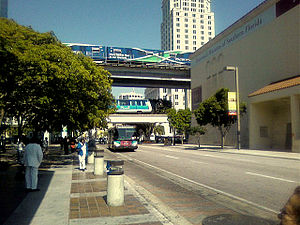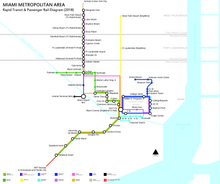
Miami-Dade Transit (MDT) is the primary public transit authority of Miami, Florida and the greater Miami-Dade County area. It is the largest transit system in Florida and the 15th-largest transit system in the United States. As of 2023, the system has 80,168,700 rides per year, or about 277,400 per weekday in the fourth quarter of 2023. MDT operates the Metrobus with their paratransit STS systems run by LSF. MDT also operates two rail transit systems: Metrorail and Metromover.
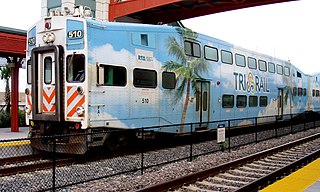
Tri-Rail is a commuter rail service linking Miami, Fort Lauderdale and West Palm Beach in Florida, United States. The Tri prefix in the name refers to the three counties served by the railroad: Palm Beach, Broward, and Miami-Dade. Tri-Rail is managed by the South Florida Regional Transportation Authority (SFRTA) along CSX Transportation's former Miami Subdivision; the line is now wholly owned by the Florida DOT. The 80.0-mile-long (128.7 km) system has 19 stations along the Southeast Florida coast, and connects directly to Amtrak at numerous stations, to Metrorail at the Metrorail Transfer station, Miami Airport station, and MiamiCentral, and to Brightline at MiamiCentral.

Metromover is a free to ride automated people mover system operated by Miami-Dade Transit in Miami, Florida, United States. Metromover serves the Downtown Miami, Brickell, Park West and Arts & Entertainment District neighborhoods. Metromover connects directly with Metrorail at Government Center and Brickell stations. It also connects to Metrobus with dedicated bus loops at Government Center and Adrienne Arsht Center station. It originally began service to the Downtown/Inner Loop on April 17, 1986, and was later expanded with the Omni and Brickell Loop extensions on May 26, 1994.

Tri-Rail and Metrorail Transfer station is a Metrorail and Tri-Rail interchange station in Hialeah, Florida, northwest of the city of Miami proper.

Civic Center station is a station on the Metrorail rapid transit system in the Health District of Miami, Florida. The station is located at the intersection of Northwest 12th Avenue and 15th Street. Civic Center provides a convenient connection for University of Miami medical students by connecting the hospital area to the main campus at University Station.

Brickell station is a Metrorail rapid transit station in Miami, Florida, serving the system's Green and Orange Lines. One of the core stations of Miami's public transport network, it serves the financial district of Brickell. Combined, the Metrorail and Metromover station complex at Brickell sees roughly 8,430 boardings each weekday, making it the system's second-busiest station.

Miami station is a train station in Miami-Dade County, Florida, on the border of Miami and Hialeah. It is the southern terminus for Amtrak's Silver Meteor and Silver Star trains. The station opened in 1978 to replace a 48-year-old Seaboard Air Line Railroad station. It is several blocks away from the Tri-Rail and Metrorail Transfer Station, but there is no direct connection between the two. The station was meant to be replaced in the mid-2010s by the Miami Intermodal Center next to the airport just to the south, but the platforms were too short. Negotiations are ongoing between Amtrak and FDOT.
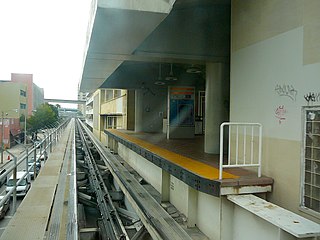
Miami Avenue is a Metromover station in Downtown, Miami, Florida.

Miami Intermodal Center (MIC) is an intermodal rapid transit, commuter rail, intercity rail, local bus, and intercity bus transportation hub in Miami-Dade County, Florida, just outside the Miami city limits near the Grapeland Heights neighborhood. The facility was constructed by the Florida Department of Transportation and is owned by the Miami-Dade Expressway Authority.
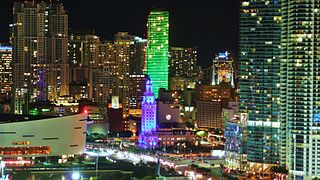
Downtown Miami is the urban city center of Miami, Florida, United States. The city's greater downtown region consists of the Central Business District, Brickell, the Historic District, Government Center, the Arts & Entertainment District, and Park West. It is divided by the Miami River and is bordered by Midtown Miami's Edgewater, and Wynwood sections to its north, Biscayne Bay to its east, the Health District and Overtown to its west, and Coconut Grove to its south.

Metrorail is a rapid transit system in Miami and Miami-Dade County in the U.S. state of Florida. Metrorail is operated by Miami-Dade Transit (MDT), a departmental agency of Miami-Dade County. Opened in 1984, it is Florida's only rapid transit metro system, and is currently composed of two lines of 23 stations on 24.4 miles (39.3 km) of standard gauge track. Metrorail serves the urban core of Miami, connecting Miami International Airport, the Health District, Downtown Miami, and Brickell with the northern developed neighborhoods of Hialeah and Medley to the northwest, and to suburban The Roads, Coconut Grove, Coral Gables, and South Miami, ending at urban Dadeland in Kendall. Metrorail connects to the Metromover in Downtown, which provides metro service to the entirety of Downtown and Brickell. Additionally, it connects to South Florida's commuter rail system at Tri-Rail station, as well as Metrobus routes at all stations. In 2023, the system had 13,439,300 rides, and about 48,300 per day in the fourth quarter of 2023.

The Stephen P. Clark Government Center, known also as Government Center, Miami-Dade Center, or County Hall, is a skyscraper in the Government Center district of Downtown Miami, Florida, United States. It is the headquarters building of the Miami-Dade County government. Many county offices are located in or near the building. The local and federal courthouses are located within five blocks of the building. The tower is 510 ft tall, and has 28 stories. It has one of the highest height-to-floor ratios of any skyscraper, at 18.2 feet per floor. The Government Center Metrorail station is located inside the building, giving it easy access to public transit. It is located in western downtown, on North First Street between West First and West Second Avenue. The building was completed in 1985. It is named after the former Mayor of Miami-Dade County and Mayor of Miami, Stephen P. Clark (1923-1996).

The Arts & Entertainment District, or previously known as Omni, is a neighborhood of Downtown Miami, Florida. It is bound roughly by North 19th Street to the north, North 10th Street to the south, North West 2nd Avenue to the west, and Biscayne Boulevard to the east.
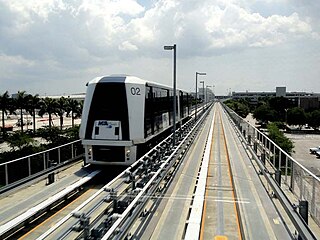
The MIA Mover is an automated people mover (APM) system which opened at the Miami International Airport (MIA) in metropolitan Miami, Florida, United States on September 9, 2011. The MIA Mover is designed to quickly transport landside passengers between Miami International Airport's Main Terminal and the Miami Intermodal Center (MIC). The MIA Mover is one of three separate automated people movers operating at the airport. The others are the Skytrain, which operates within Concourse D, and the MIA e Train people mover connecting Concourse E's satellite building.

Government Center is a district in the western portion of downtown Miami, Florida bound roughly by I-95 and West (NW/SW) 3rd Avenue to the west, South (SW/SE) 1st Street to the south, North (NE/NW) 5th Street to the north, and East (NE/SE) 1st Avenue to the east.

The Greater Miami area, composed of the three counties of Miami-Dade, Broward, and Palm Beach, also known collectively as South Florida, is home to a wide variety of public and private transportation systems. These include heavy rail mass transit (Metrorail), commuter rail (Tri-Rail), automated guideway transit (Metromover), highways, two major airports and seaports, as well as three county-wide bus networks, which cover the entire urbanized area of South Florida. Census and ridership data show that Miami has the highest public transportation usage of any city in Florida, as about 17% of Miamians use public transportation on a regular basis, compared to about 4% of commuters in the South Florida metropolitan area. The majority of public transportation in Miami is operated by Miami-Dade Transit (MDT), which is currently the largest transit system in Florida and was the 14th largest transit system in the United States in 2011.

The Metrobus network provides bus service throughout Miami-Dade County 365 days a year, operated by Miami-Dade Transit. It consists of about 79 routes and 893 buses, which connect most points in the county and part of southern Broward County as well. As of 2023, the system has 58,282,300 rides per year, or about 201,200 per day in the fourth quarter of 2023.

The Central Business District (CBD) of Miami is the historic central business district and city center of what has become Greater Downtown Miami in Miami, Florida. Over 92,000 people work in Miami's Central Business District.
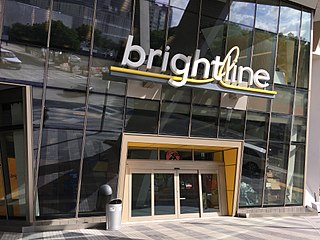
MiamiCentral is a train station in Miami, Florida. Located in Downtown Miami, the station provides access to the Brightline inter-city rail service and the Tri-Rail commuter rail service. The station is part of a 9-acre (3.6 ha) mixed-use complex, which includes 3 million square feet (280,000 m2) of residential, office, commercial, and retail development.
